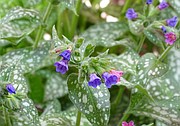Foliage takes top billing over flowers in leafy landscapes
There are those in the landscaping world who do not dote on flowers but prefer the many forms, textures and variety of colors available in foliage plants. This is an understandable preference when one considers the enormous array of beautiful ornamentals in which flowers are secondary to the drama of the leaves.
Many come to mind: Berginia — super hardy with large, shiny-green rounded leaves that provide protection for a few early spring flower stalks, replete with bright pink blossoms that take second fiddle to the evergreen foliage; Hosta — with an awesome selection of leaf color from true green, blue-green, lime and more, plus a variety of bi-colors in designs from stripes to outline patterns of white, pale yellow and all the aforementioned colors. The summer flower stalks that rise high above the leaf mounds are lovely in white, pale lavender, and pink, but humble in comparison with the beautiful, long-lasting leaves; Heuchera, or coral bells, have come a long way from their wild alumroot forebears, with lavish leaf colors including pink, purple, lime, orange, red, burgundy, again with fragile stems of small flowers barely noticeable as they rise above the glorious basal leaves.
Pulmonaria (Lungwort) is another beauty, with silver-spotted green leaves arrayed around the sweet but small pink and blue flowers that bloom in the spring, then leave the foliage to hold its own for the rest of the season.
Ferns, with their fragile beauty that belies their hardiness, are natural in the foliate garden, thriving with any and all of our previous suggestions. A little shade for all of them, semi-acidic soil, and occasional watering are all they ask, with the exception of the Hostas, which must be checked periodically for snails and slugs, which love them. Look for products that are non-toxic to pets and small animals; and stay away from those which contain toxic iron compounds.)
Annual lovers dote on Coleus, dependable for a yearly knock-out show, and beloved by container gardeners for its multi-colored beauty. Velvety leaves in lime, burgundy, purple and pink grow lavishly in a sunny site — accepting a little dappled shade — and just grow and expand until a couple of hard frosts do it in. It is definitely the drama queen of the annuals.
A recent favorite is Sweet Potato vine, a chartreuse, lavishly leaved possibility, which sends its large leaves wandering prettily through the landscape. It prefers a drier, sunny site. An every-season favorite is the Nasturtium, hardy and practical, whose rounded leaves — as well as the less-dense flowers — are not only the perfect groundcover along paths but take as well to pots, draping gracefully down and supporting their blossoms that now come in cream, red, burgundy and gold as well as the original orange. Both leaves and flowers are edible, and a crisp attractive addition to summer salads.
While we’re on the subject of edibles, more and more professionally created gardens are planted with culinary focal points in the best practical application of gardening. Consider a great Rhubarb plant; a few clusters of Rainbow Chard with its curly, shiny green leaves and red, yellow, and white stalks; a border of parsley, chives or Alpine strawberries; Violets, too, with their heart-shaped leaf cover, are lovely around rocks or bordering walkways.
Major leaved plants that remain throughout the growing season include Daylilys, which provide green and attractive arching leaves long after the flowers have finished their day-long bloom-and-die process; Ornamental Kale offers ruffled purple/pink/green and white drama anywhere in the landscape (chop a few leaves into the soup, if you wish); and Egyptian “walking onions” hold great succulent, eye-stopping two-foot tall “leaves” that twist and curl into amazing shapes holding tiny bulblet “bouquets” at the ends.
Leafy shrubs include: Sage (Salvia), now available in purple, burgundy, and variegated-leaved varieties for season-long color, again with unobtrusive pink flower spikes in the fall; Nepeta, small-leaved but bushy and attractive when mature, offering lovely minty scent when brushed against; low-growing blueberry such as Tophat, while not as leafy as the first two, provides luscious berries in the autumn as well as a magnificent burst of red leaves after frost. Probably the prettiest and hardiest of the shrubs is our native Pachistima, often called Mountain Lover or Oregon box, but much more dependable in our climate than the true box. Its slightly serrated evergreen leaves cover the shrub, and tiny pink blossoms herald the spring. Great as a single shrub or as a hedge plant.
One mustn’t forget the Artemisias with its silver-gray, ferny lushness. They add unexpected drama to special nooks and are available in mounded, arched/tall and shrub varieties (Silver Mound, Silver King, Southernwood) — some are hardier than others, but most respond nicely to protective mulch in late fall. Stachys, or Woolly Lamb’s Ears, offers tall, fuzzy leaves for the kiddies to pet, with delicate almost unnoticeable lavender-pink blooms on the center stalk in summer. Lady’s Mantle (Alchemilla mollis) provides the unusual color of chartreuse to the landscape, with rounded, mounded leaves of that color and lime-yellow flowers in late spring. The flowers of Lady’s Mantle are the same color as those of Oregon Grape (Mahonia), a possible companion, and another good leafy choice, with its holly-like foliage. All four of these prefer the sun and handle a drier site than many other choices.
In the realm of small, leafy trees, many people plan for a Japanese maple. Unless you (a) have major protection, (b) live in Hope, or (c) have a mini-ecosystem that’s Zone 5, I wouldn’t recommend it since it is not reliably hardy here. Our native Rocky Mountain Maple is a much better choice and can be pruned from a single central trunk to a shrubby multi-stemmed small tree, which is graceful, beautiful, and provides fall color with its red and yellow leaves.
Doubtless, grasses will be part of a foliage landscape, and there are many to choose from. Our native Idaho blue fescue grows in attractive mounds with tall seed-bearing stalks rising from the center in late summer and is truly hardy. Many grasses, including some of the Miscanthus, are not reliable in our fussy climate, and some research is called for. Check out various catalogs, talk with two or three nursery or greenhouse owners, and make your choices for our Zone 3-4-5 area.
As usual, we’ve only touched the tip of the foliage iceberg, but perhaps you’ll be inspired to look into many more possibilities. Have fun planning your leafy landscape!
(Editor’s note: For many years, Valle Novak wrote gardening and cooking columns for the Daily Bee. “Weekend Gardener” and “Country Chef” became renowned for their humor, information, and common sense advice on how to do everything from planting to cooking. While she recently passed away, she has left behind a number of columns to share with and delight her many fans. This is one such column and was originally published on April 18, 2010.)





